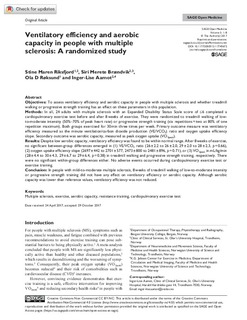| dc.contributor.author | Riksfjord, Stine Maren Langholm | |
| dc.contributor.author | Brændvik, Siri Merete | |
| dc.contributor.author | Røksund, Ola Drange | |
| dc.contributor.author | Aamot, Inger Lise | |
| dc.date.accessioned | 2019-03-29T08:47:08Z | |
| dc.date.available | 2019-03-29T08:47:08Z | |
| dc.date.created | 2018-01-05T15:56:54Z | |
| dc.date.issued | 2017 | |
| dc.identifier.citation | Riksfjord, S. M., Brændvik, S. M., Røksund, O. D. & Aamot, I.-L. (2017). Ventilatory efficiency and aerobic capacity in people with multiple sclerosis: A randomized study. SAGE Open Medicine, 5. | nb_NO |
| dc.identifier.issn | 2050-3121 | |
| dc.identifier.uri | http://hdl.handle.net/11250/2592352 | |
| dc.description.abstract | Objectives:
To assess ventilatory efficiency and aerobic capacity in people with multiple sclerosis and whether treadmill walking or progressive strength training has an effect on these parameters in this population.
Methods:
In all, 24 adults with multiple sclerosis with an Expanded Disability Status Scale score of ≤6 completed a cardiopulmonary exercise test before and after 8 weeks of exercise. They were randomized to treadmill walking of low-to-moderate intensity (50%–70% of peak heart rate) or progressive strength training (six repetitions × two at 80% of one repetition maximum). Both groups exercised for 30 min three times per week. Primary outcome measure was ventilatory efficiency measured as the minute ventilation/carbon dioxide production (VE/VCO2) ratio and oxygen uptake efficiency slope. Secondary outcome was aerobic capacity, measured as peak oxygen uptake (VO2peak).
Results:
Despite low aerobic capacity, ventilatory efficiency was found to be within normal range. After 8 weeks of exercise, no significant between-group differences emerged in (1) VE/VCO2 ratio (26 ± 2.2 to 26 ± 2.0, 29 ± 2.0 to 28 ± 2.3, p = 0.66), (2) oxygen uptake efficiency slope (2697 ± 442 to 2701 ± 577, 2473 ± 800 to 2481 ± 896, p = 0.71), or (3) VO2peak in mL/kg/min (28 ± 4.4 to 30 ± 4.3, 29 ± 6.7 to 29 ± 6.4, p = 0.38) in treadmill walking and progressive strength training, respectively. There were no significant within-group differences either. No adverse events occurred during cardiopulmonary exercise test or exercise training.
Conclusion:
In people with mild-to-moderate multiple sclerosis, 8 weeks of treadmill walking of low-to-moderate intensity or progressive strength training did not have any effect on ventilatory efficiency or aerobic capacity. Although aerobic capacity was lower than reference values, ventilatory efficiency was not reduced. | nb_NO |
| dc.language.iso | eng | nb_NO |
| dc.publisher | Sage | nb_NO |
| dc.rights | Navngivelse-Ikkekommersiell 4.0 Internasjonal | * |
| dc.rights.uri | http://creativecommons.org/licenses/by-nc/4.0/deed.no | * |
| dc.subject | multiple sclerosis | nb_NO |
| dc.subject | aerobic capacity | nb_NO |
| dc.subject | exercise | nb_NO |
| dc.subject | resistance training | nb_NO |
| dc.subject | cardiopulmonary exercise test | nb_NO |
| dc.title | Ventilatory efficiency and aerobic capacity in people with multiple sclerosis: A randomized study | nb_NO |
| dc.type | Journal article | nb_NO |
| dc.type | Peer reviewed | nb_NO |
| dc.description.version | publishedVersion | nb_NO |
| dc.rights.holder | © The Author(s) 2017. | nb_NO |
| dc.subject.nsi | VDP::Medisinske Fag: 700::Basale medisinske, odontologiske og veterinærmedisinske fag: 710::Patofysiologi: 721 | nb_NO |
| dc.source.pagenumber | 1-8 | nb_NO |
| dc.source.volume | 5 | nb_NO |
| dc.source.journal | SAGE Open Medicine | nb_NO |
| dc.identifier.doi | 10.1177/2050312117743672 | |
| dc.identifier.cristin | 1536852 | |
| cristin.unitcode | 203,3,11,0 | |
| cristin.unitname | Institutt for ergo/fysio/radio - Bergen | |
| cristin.ispublished | true | |
| cristin.fulltext | original | |
| cristin.qualitycode | 1 | |

